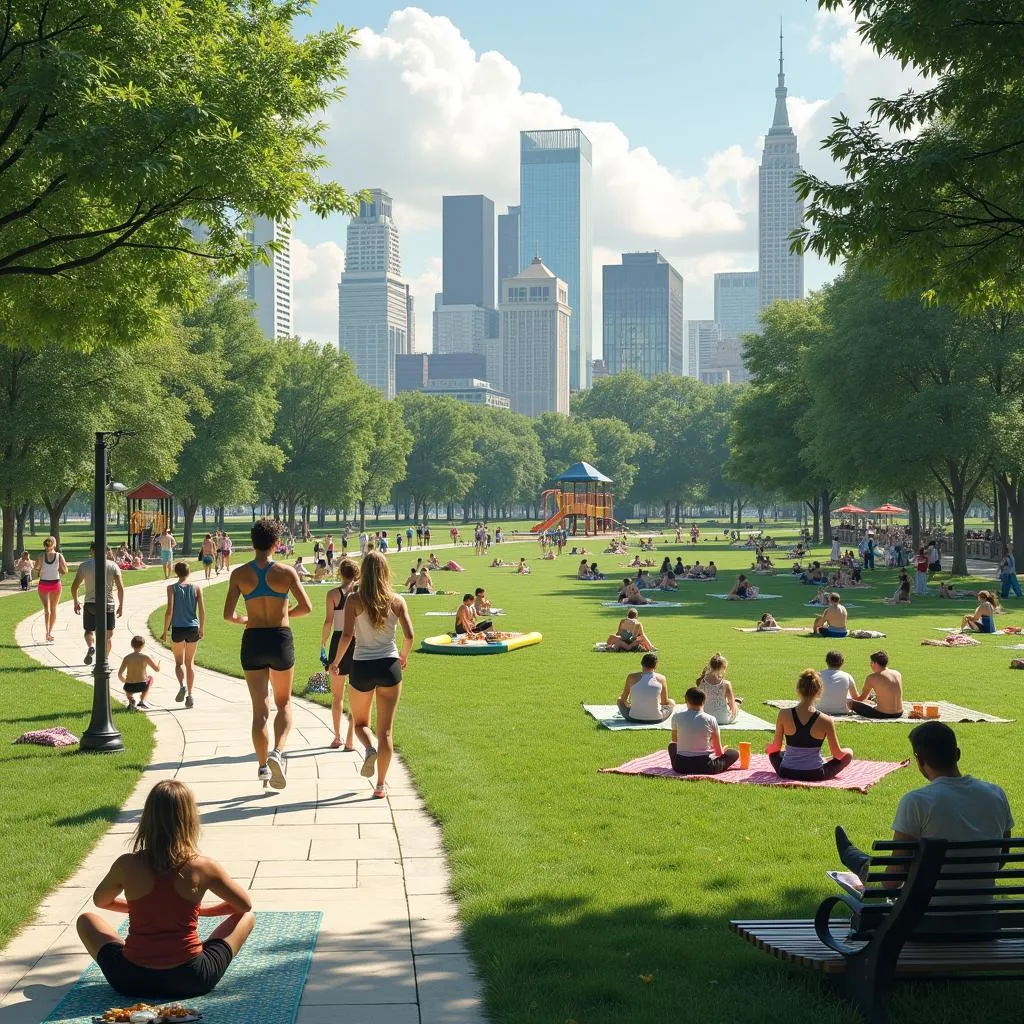The IELTS Speaking test often includes questions about travel and famous places, making “describe a famous place in your country you want to revisit” a highly probable topic. This theme has appeared frequently in past exams and is likely to remain relevant in future tests. Let’s explore how to excel in answering questions related to this subject across all parts of the IELTS Speaking exam.
Nội dung bài viết
Part 1: Introduction and Interview
In this section, the examiner may ask general questions about famous places and travel experiences. Here’s a sample question with a suggested answer:
Question: Do you enjoy visiting famous places in your country?
Answer (Band 7-8):
Absolutely! I find great pleasure in exploring renowned locations in my country. Not only does it allow me to delve deeper into our rich cultural heritage, but it also gives me a chance to appreciate the diverse landscapes we have. Each visit is like unwrapping a new layer of history and beauty, which I find incredibly fascinating and enriching.
Describe a nature trip you would like to plan to complement your exploration of famous places within your country.
Part 2: Long Turn (Cue Card)
Here’s a sample cue card related to the topic:
Describe a famous place in your country that you want to revisit
You should say:
- Where this place is
- When you first visited it
- What you did there
- And explain why you want to visit it againSample Answer (Band 6-7):
I’d like to talk about the Taj Mahal, a world-famous monument located in Agra, India. I first visited this magnificent structure about five years ago during a family vacation.
When we arrived, I was immediately struck by its sheer grandeur. We spent hours exploring the intricate marble carvings and admiring the symmetrical gardens. I remember taking countless photos to capture its beauty from different angles.
I want to revisit the Taj Mahal because my first visit left me yearning for more. There’s so much history and architectural detail that I feel I barely scratched the surface. Plus, I’ve heard that the view at sunrise is breathtaking, which I missed last time. I believe a second visit would allow me to appreciate its beauty on a deeper level and perhaps uncover hidden aspects I overlooked before.
Sample Answer (Band 8-9):
I’d be delighted to describe the Taj Mahal, an iconic architectural marvel situated in Agra, India, which I’m eager to revisit. My initial encounter with this resplendent monument occurred approximately five years ago during a family sojourn.
Upon arrival, I was utterly captivated by its ethereal beauty and pristine white marble facade. We spent a considerable amount of time meticulously examining the intricate inlay work and marveling at the perfect symmetry of both the structure and its surrounding Mughal gardens. I distinctly recall attempting to capture its timeless elegance through my camera lens from various vantage points.
My desire to return to the Taj Mahal stems from a profound sense that my first visit merely skimmed the surface of its historical and architectural significance. I’m particularly intrigued by the prospect of witnessing the monument at dawn, when the first rays of sunlight caress the dome, creating an ethereal ambiance that I regrettably missed during my previous visit. I believe a second journey would afford me the opportunity to delve deeper into its rich tapestry of history and perhaps uncover nuances in its design that eluded me before. Moreover, I’m keen to experience the changing moods of the monument throughout the day, from the soft glow of sunrise to the golden hues of sunset.
 Breathtaking sunrise view of the Taj Mahal
Breathtaking sunrise view of the Taj Mahal
Follow-up Questions:
- How has your perception of this place changed since your first visit?
Answer (Band 7-8): Since my first visit, my appreciation for the Taj Mahal has grown exponentially. I’ve done more research on its history and architectural techniques, which has deepened my understanding of its significance. Now, I see it not just as a beautiful building, but as a testament to human craftsmanship and devotion. This newfound knowledge has made me even more eager to revisit and observe details I might have overlooked before.
Answer (Band 8-9): My perception of the Taj Mahal has undergone a profound transformation since my initial visit. Through extensive research into its rich history and the intricate architectural principles employed in its construction, I’ve developed a far more nuanced appreciation of this magnificent structure. What once struck me primarily as an aesthetic marvel has now revealed itself as a multifaceted symbol of cultural heritage, artistic innovation, and enduring love. This deeper understanding has ignited an intense curiosity to re-examine the monument through a more informed lens, potentially uncovering layers of meaning and craftsmanship that previously eluded my notice.
- Do you think famous places in your country are well-preserved?
Answer (Band 7-8): In my opinion, the preservation of famous places in India is a mixed bag. While some monuments, like the Taj Mahal, are relatively well-maintained due to their international fame and tourism revenue, many lesser-known historical sites are struggling with neglect. The government has made efforts to protect these places, but challenges like pollution, overcrowding, and lack of funds often hinder preservation efforts. I believe there’s room for improvement in terms of conservation strategies and public awareness about the importance of preserving our cultural heritage.
Answer (Band 8-9): The preservation of famous places in India presents a complex and nuanced picture. While iconic monuments such as the Taj Mahal receive considerable attention and resources for their upkeep, largely due to their global renown and significant tourism revenue, numerous lesser-known historical sites grapple with issues of neglect and deterioration. The government has implemented various conservation initiatives, yet these efforts often face formidable challenges including environmental pollution, the strain of mass tourism, and budgetary constraints. I believe there’s a pressing need for a more comprehensive and sustainable approach to heritage conservation, one that balances tourism development with preservation, incorporates cutting-edge conservation technologies, and fosters greater public engagement in safeguarding our rich cultural legacy.
Part 3: Two-way Discussion
In this section, the examiner will ask more abstract questions related to famous places and tourism. Here are some sample questions and answers:
Question 1: How do you think tourism affects famous places in a country?
Answer (Band 6-7):
Tourism can have both positive and negative effects on famous places. On the positive side, it brings in money that can be used for preservation and improvements. It also helps spread awareness about the place’s cultural importance. However, too many tourists can cause problems like overcrowding and damage to the site. It’s important to find a balance between allowing people to visit and protecting these special places.
Answer (Band 8-9):
The impact of tourism on famous landmarks is undeniably double-edged. On one hand, it serves as a vital economic lifeline, generating substantial revenue that can be channeled into conservation efforts and infrastructure improvements. Moreover, it plays a crucial role in fostering cultural exchange and raising global awareness about the historical and artistic significance of these sites.
However, the influx of visitors can also pose significant challenges. Overtourism can lead to physical degradation of the site, as well as dilute the authentic cultural experience for both visitors and local communities. There’s also the risk of commercialization overshadowing the intrinsic value of these places.
To mitigate these issues, a delicate balance must be struck between accessibility and preservation. This might involve implementing visitor quotas, promoting sustainable tourism practices, and investing in cutting-edge conservation technologies. Ultimately, the goal should be to ensure that these iconic places can be enjoyed by future generations without compromising their integrity or cultural significance.
Describe a place you visited that you would like to go back to for a more comprehensive understanding of tourism’s impact on popular destinations.
Question 2: In what ways can governments better protect and promote famous places?
Answer (Band 7-8):
Governments can take several steps to better protect and promote famous places. They could increase funding for conservation efforts and implement stricter regulations on visitor behavior. Promoting these places through educational programs in schools and media campaigns can raise awareness about their importance. Additionally, governments could collaborate with local communities to ensure sustainable tourism practices that benefit both the site and the people living nearby.
Answer (Band 8-9):
Governments can adopt a multifaceted approach to enhance the protection and promotion of famous places. Firstly, they should allocate substantial resources towards conservation efforts, employing cutting-edge technologies for restoration and maintenance. This could be complemented by implementing adaptive management strategies that respond to changing environmental and social conditions.
Secondly, governments should focus on sustainable tourism development. This involves setting carrying capacities for sites, promoting off-peak visitation, and developing alternative attractions to disperse tourist flows. They could also incentivize eco-friendly practices among tourism operators and visitors.
Furthermore, fostering public-private partnerships can bring in additional expertise and funding for preservation projects. Governments should also invest in comprehensive educational programs that not only promote these sites but also instill a sense of stewardship among citizens and visitors alike.
Lastly, leveraging digital platforms for virtual tours and augmented reality experiences can help manage physical visitor numbers while still allowing people to engage with these cultural treasures. By adopting such a holistic approach, governments can ensure the long-term preservation of famous places while maximizing their cultural and economic benefits.
 Infographic on sustainable tourism practices
Infographic on sustainable tourism practices
Key Vocabulary and Phrases for High Scores
-
Architectural marvel /ˌɑːkɪˈtektʃərəl ˈmɑːvəl/ (noun phrase): A building or structure that is exceptionally beautiful or impressive.
Example: The Taj Mahal is widely regarded as an architectural marvel of the Mughal era. -
Cultural heritage /ˈkʌltʃərəl ˈherɪtɪdʒ/ (noun phrase): The legacy of physical artifacts and intangible attributes of a group or society.
Example: Visiting famous places helps us appreciate our rich cultural heritage. -
Intricate /ˈɪntrɪkət/ (adjective): Very complicated or detailed.
Example: The intricate carvings on the walls of the temple left me in awe. -
Resplendent /rɪˈsplendənt/ (adjective): Attractive and impressive through being richly colorful or sumptuous.
Example: The palace was resplendent in its decorations, with gold leaf adorning every surface. -
To delve deeper /tə delv ˈdiːpər/ (verb phrase): To research or examine something thoroughly.
Example: On my second visit, I hope to delve deeper into the history behind this famous monument.
Describe a place where you like to go for long walks to practice using these vocabulary items in a different context.
Examiner’s Advice
To achieve a high score in the IELTS Speaking test when describing famous places:
-
Expand your vocabulary: Use a wide range of descriptive words and phrases to vividly portray the place.
-
Provide specific details: Don’t just say it was beautiful; explain why and how it affected you.
-
Link your ideas: Use connecting words to make your speech flow naturally.
-
Practice pronunciation: Ensure you can clearly articulate place names and complex vocabulary.
-
Show enthusiasm: Your tone should convey genuine interest in the topic.
-
Relate personal experiences: This adds authenticity to your description and showcases your language skills in narrating past events.
Remember, the key to success is not just knowing what to say, but how to say it effectively and fluently. Regular practice with a variety of topics will help you build confidence and improve your performance in the IELTS Speaking test.
Describe a time when you went on a hike to further enhance your descriptive skills and vocabulary related to places and experiences.


